328. Arctic Tern Sterna paradisaea (Arktiese sterretjie)
Order: Charadriiformes. Family: Laridae
Description
Length 33–39 cm, weight 76-116 g. They are white with black caps and grey mantles, and a deeply-forked tail. In breeding season, the entire bill is blood-red. Their legs are so short that the birds appear to be crouched when standing.
Breeding adult: Black forehead, nape and crown and white cheeks; the mantle, back and upper wings are grey with the area near the wingtip being translucent and the collar, rump and underwing are white. The deeply forked tail is white with grey outer webs. The long bill, legs and feet are red.
Non-breeding adult and immature: Forehead white, crown streaked black and white, nape black. The bill is black and the legs and feet dark red to blackish. In flight, in non-breeding plumange the grey back contrasts with white rump and tail while all primaries appear translucent.
Juveniles differ from adults in their black bill and legs, "scaly" appearing wings, and mantle with dark feather tips, dark carpal wing bar, and short tail streamers.
Similar species: Compared to the Common Tern, it has a longer tail and mono-coloured bill. The non-breeding adult resembles the Antarctic Tern, but Antarctic Tern retains breeding plumage from October to April, and Arctic Tern from April to September.
Juvenile differs from juvenile Common Tern by its reduced carpal bar and pale secondaries, and by the marked contrast between the white rump and the grey back.
Distribution
Breeds from North America to the White Sea of Russia, heading south in the non-breeding season to the Southern Ocean and adjacent cold sea in the Humboldt Current passing South America and the Benguela Current passing southern Africa. Within southern Africa it is uncommon off the west coast, while more scarce further out to sea and off the southern and eastern coast of the region.
Habitat
Oceans. Pelagic, sometimes roosts ashore.
Movements and migrations
The Arctic Tern is well known for its long yearly migration. It travels from its Arctic breeding grounds to its wintering grounds off of Antarctica. It covers up to 40,000km which is the farthest yearly journey of any bird. It is mainly passage migrant through southern African waters, occurring from September-January.
Diet
It eats small fish or marine crustaceans.
Breeding
Breeding begins around the third or fourth year. They mate for life, and in most cases, return to the same colony each year. Courtship is elaborate and begins with a so-called "high flight", where a female will chase the male to a high altitude and then slowly descend. This display is followed by "fish flights", where the male will offer fish to the female. Courtship on the ground involves strutting with a raised tail and lowered wings. After this, both birds will usually fly and circle each other. The nest is usually a depression in the ground and 1-3 mottled eggs are laid. Both sexes share incubation duties. The young hatch after 22 to 27 days and fledge after 21 to 24 days. They nest once every one to three years (depending on its mating cycle); once it has finished nesting it takes to the sky for another long southern migration.
Call
Shrill short kik-kik in flight. Listen to Bird Call.
Status
Fairly uncommon but regular passage migrant and summer visitor. The Arctic Tern is classified as Least Concern (LC) on the IUCN Red List.
Africa Wild Bird Book
Arctic Tern Photos
328. Arctic Tern Sterna paradisaea
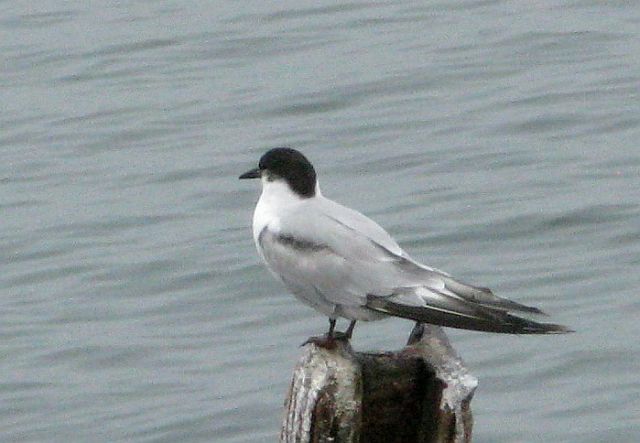
Non-breeding plumage, Namibia
 © Michele Nel
© Michele Nel
Non-breeding
 © Mel
© Mel
Adult breeding, Germany
 © Mel
© Mel
 © Dewi
© Dewi
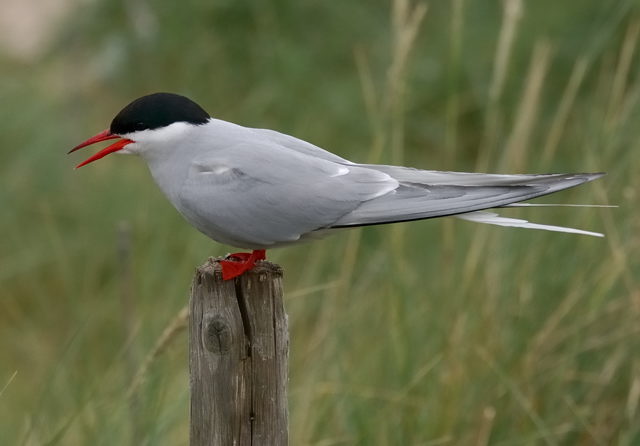 © Dewi
© Dewi
Adult breeding
 © Dewi
© Dewi
Adult breeding
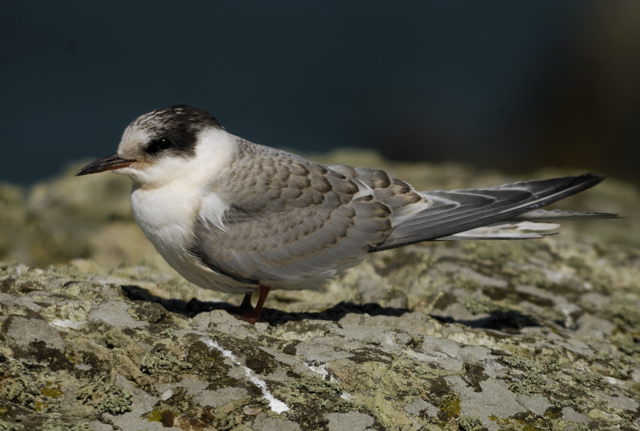 © Dewi
© Dewi
Fledged juvenile
 © Dewi
© Dewi
Fledged juvenile
 © Mel
© Mel
Moulting, with some of the retained juvenile feathers
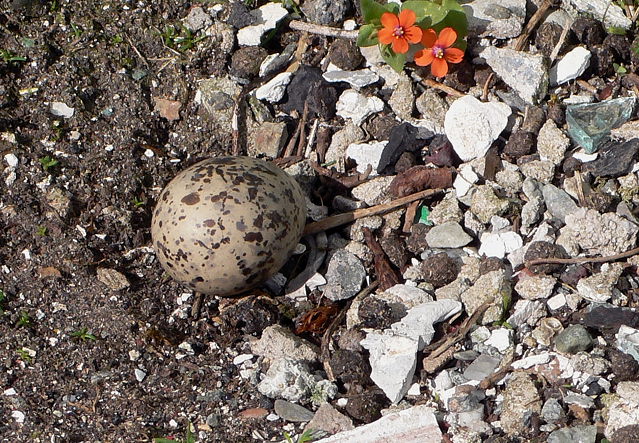 © Dewi
© Dewi
Egg
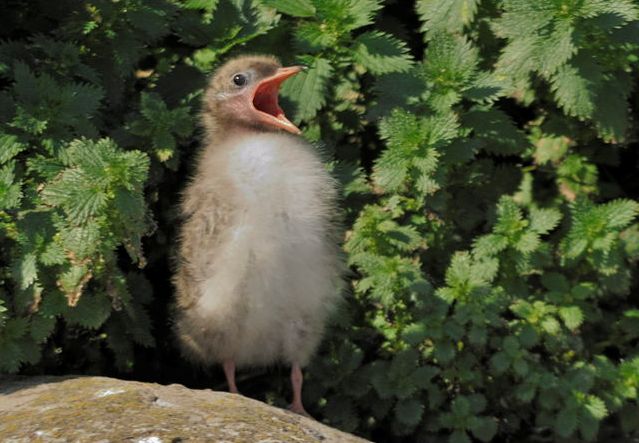 © Dewi
© Dewi
Chick
Links:
Sabap2
Sabap1
Arkive
Wikipedia: http://en.wikipedia.org/wiki/Arctic_Tern

Non-breeding plumage, Namibia
 © Michele Nel
© Michele NelNon-breeding
 © Mel
© MelAdult breeding, Germany
 © Mel
© Mel © Dewi
© Dewi © Dewi
© DewiAdult breeding
 © Dewi
© DewiAdult breeding
 © Dewi
© DewiFledged juvenile
 © Dewi
© DewiFledged juvenile
 © Mel
© MelMoulting, with some of the retained juvenile feathers
 © Dewi
© DewiEgg
 © Dewi
© DewiChick
Links:
Sabap2
Sabap1
Arkive
Wikipedia: http://en.wikipedia.org/wiki/Arctic_Tern
Antarctic Tern
329. Antarctic Tern Sterna vittata (Grysbonsterretjie)
Order: Charadriiformes. Family: Laridae
Description
Length 34-36 cm. Wingspan 74-79 cm. It is mainly pale grey and white. Rump is white. The tips of this tern's wings are greyish black.
In breeding plumage, it has a black cap, extending to the crown and back of the neck. The upperparts of the body are pale grey, contrasting with the white rump and white forked tail, and the underparts are generally grey-white, with white undertail coverts. The eyes are brownish-black and the bill and legs are bright red.
The non-breeding adult appears similar, but the forehead is white and the crown is grizzled, streaked with white. The underparts are whiter outside of the breeding season, and the bill and legs vary from reddish-black to dull red.
The juvenile typically has a white forecrown, streaked with black, and a dark brownish-grey to blackish-grey hindcrown. The upperparts are typically grey with heavy black and buff bars, and white on the underparts with fine black barring. The feathers of young juvenile Antarctic terns usually have scaly dark tips, but these wear quickly and are not present in older juveniles. Year-old juveniles have a white forehead, similar to the breeding adult, as well as white underparts and a dull reddish-black bill.
Similar species: Appears more robust than Common Tern or Arctic Tern with greyer underparts which contrast with the white line between the dark cap. Bill is also heavier than these two species. It is very similar in appearance to the closely related Arctic Tern, but is stockier, and the wing tips are grey instead of blackish in flight.
The non-breeding adult resembles the Arctic Tern, but Antarctic Tern retains breeding plumage from October to April, and Arctic Tern from April to September.
Distribution
It ranges throughout the southern oceans. The Antarctic Tern breeds on a large number of sub-Antarctic islands in the Southern Oceans from New Zealand westwards to South America and off the coast of Antarctica. It winters on the coast of Argentina and South Africa, particularly along the coastline and offshore islands of the Western and Eastern Cape provinces of South Africa. A reasonably common non-breeding winter visitor to the coast along the Cape, with smaller numbers to the East coast. Some birds remain on the West coast in the Summer. It is common the southwestern and eastern Cape Province between Lambert’s Bay and East London. Elsewhere along the coast of southern Africa it occurs as a vagrant.
During the non-breeding season, South Africa supports about 10% of the world population; visiting birds belong to two races: the nominate race which breeds on islands in the southern Indian Ocean and winters mainly on the east coast of southern Africa, and S. v. tristanensis from Tristan da Cunha and Gough islands which winters mainly on the southern and west coasts.
Habitat
During the breeding season, the Antarctic tern inhabits rocky islands or rocky areas near the coast. Outside of the breeding season, the Antarctic tern is primarily pelagic, roaming over large areas of open water. In South Africa, it generally inhabits rocky headlands and beaches.
Movements and migration
The Antarctic Tern is migratory, typically travelling long distances from its breeding grounds to winter off the coasts of South America and South Africa. In South Africa, wintering Antarctic terns arrive in April and May, although individuals continue to arrive through to August. Generally, most terns depart for the breeding grounds in September and October, although some isolated individuals do remain during the summer months. Similarly, some populations of the Antarctic tern remain close to the breeding grounds all year round.
It often arrives while still in nuptial plumage and reassumes this plumage before return migration to breeding localities.
Diet
The Antarctic Tern feeds almost exclusively on small fish, but it may also take small quantities of molluscs, crustaceans, insects and algae. It feeds alone or in small flocks, although it may fish in flocks of up to several hundred birds where prey is abundant. It forages by hovering 2-15 m above the water, before dipping or plunge-diving below the surface of the water in pursuit of prey.
Breeding
Breeding takes place from mid-November to early December, although the exact timing varies with location, climate and food availability. The Antarctic tern forms loose breeding colonies of around 5 to 20 pairs, but pairs will also nest alone or, more rarely, in large flocks of up to 1,000 pairs. Generally, 1 or 2 eggs are laid in a shallow pebble-or shell-lined scrape on the ground, and are incubated by both adults for 23 to 25 days. The chicks typically leave the nest and hide 3 or 4 days after hatching, although they are unable to fly until they fledge at 25 to 32 days old. The young Antarctic terns are fed and cared for by the adults for some time before they become independent.
Call
Shrill high-pitched trr-trr-kriah. Listen to Bird Call.
Status
Common winter visitor.
Order: Charadriiformes. Family: Laridae
Description
Length 34-36 cm. Wingspan 74-79 cm. It is mainly pale grey and white. Rump is white. The tips of this tern's wings are greyish black.
In breeding plumage, it has a black cap, extending to the crown and back of the neck. The upperparts of the body are pale grey, contrasting with the white rump and white forked tail, and the underparts are generally grey-white, with white undertail coverts. The eyes are brownish-black and the bill and legs are bright red.
The non-breeding adult appears similar, but the forehead is white and the crown is grizzled, streaked with white. The underparts are whiter outside of the breeding season, and the bill and legs vary from reddish-black to dull red.
The juvenile typically has a white forecrown, streaked with black, and a dark brownish-grey to blackish-grey hindcrown. The upperparts are typically grey with heavy black and buff bars, and white on the underparts with fine black barring. The feathers of young juvenile Antarctic terns usually have scaly dark tips, but these wear quickly and are not present in older juveniles. Year-old juveniles have a white forehead, similar to the breeding adult, as well as white underparts and a dull reddish-black bill.
Similar species: Appears more robust than Common Tern or Arctic Tern with greyer underparts which contrast with the white line between the dark cap. Bill is also heavier than these two species. It is very similar in appearance to the closely related Arctic Tern, but is stockier, and the wing tips are grey instead of blackish in flight.
The non-breeding adult resembles the Arctic Tern, but Antarctic Tern retains breeding plumage from October to April, and Arctic Tern from April to September.
Distribution
It ranges throughout the southern oceans. The Antarctic Tern breeds on a large number of sub-Antarctic islands in the Southern Oceans from New Zealand westwards to South America and off the coast of Antarctica. It winters on the coast of Argentina and South Africa, particularly along the coastline and offshore islands of the Western and Eastern Cape provinces of South Africa. A reasonably common non-breeding winter visitor to the coast along the Cape, with smaller numbers to the East coast. Some birds remain on the West coast in the Summer. It is common the southwestern and eastern Cape Province between Lambert’s Bay and East London. Elsewhere along the coast of southern Africa it occurs as a vagrant.
During the non-breeding season, South Africa supports about 10% of the world population; visiting birds belong to two races: the nominate race which breeds on islands in the southern Indian Ocean and winters mainly on the east coast of southern Africa, and S. v. tristanensis from Tristan da Cunha and Gough islands which winters mainly on the southern and west coasts.
Habitat
During the breeding season, the Antarctic tern inhabits rocky islands or rocky areas near the coast. Outside of the breeding season, the Antarctic tern is primarily pelagic, roaming over large areas of open water. In South Africa, it generally inhabits rocky headlands and beaches.
Movements and migration
The Antarctic Tern is migratory, typically travelling long distances from its breeding grounds to winter off the coasts of South America and South Africa. In South Africa, wintering Antarctic terns arrive in April and May, although individuals continue to arrive through to August. Generally, most terns depart for the breeding grounds in September and October, although some isolated individuals do remain during the summer months. Similarly, some populations of the Antarctic tern remain close to the breeding grounds all year round.
It often arrives while still in nuptial plumage and reassumes this plumage before return migration to breeding localities.
Diet
The Antarctic Tern feeds almost exclusively on small fish, but it may also take small quantities of molluscs, crustaceans, insects and algae. It feeds alone or in small flocks, although it may fish in flocks of up to several hundred birds where prey is abundant. It forages by hovering 2-15 m above the water, before dipping or plunge-diving below the surface of the water in pursuit of prey.
Breeding
Breeding takes place from mid-November to early December, although the exact timing varies with location, climate and food availability. The Antarctic tern forms loose breeding colonies of around 5 to 20 pairs, but pairs will also nest alone or, more rarely, in large flocks of up to 1,000 pairs. Generally, 1 or 2 eggs are laid in a shallow pebble-or shell-lined scrape on the ground, and are incubated by both adults for 23 to 25 days. The chicks typically leave the nest and hide 3 or 4 days after hatching, although they are unable to fly until they fledge at 25 to 32 days old. The young Antarctic terns are fed and cared for by the adults for some time before they become independent.
Call
Shrill high-pitched trr-trr-kriah. Listen to Bird Call.
Status
Common winter visitor.
Dewi
What is the good of having a nice house without a decent planet to put it on? (H D Thoreau)
What is the good of having a nice house without a decent planet to put it on? (H D Thoreau)
Antarctic Tern Photos
329. Antarctic Tern Sterna vittata
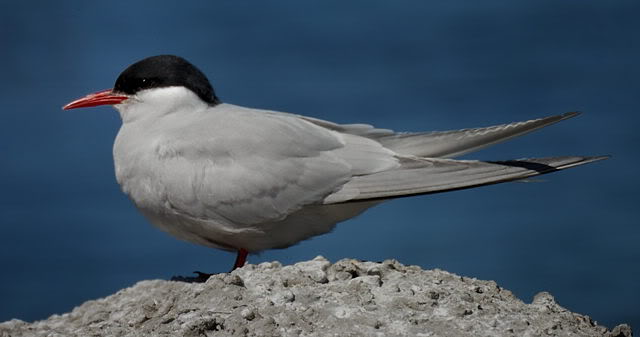
Breeding adult
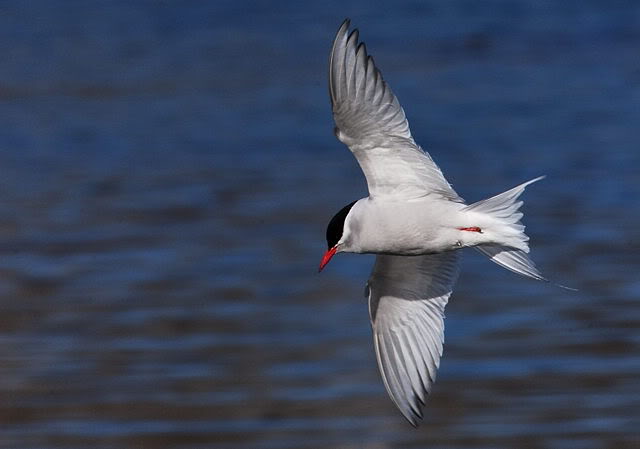
Breeding adult

Breeding adult
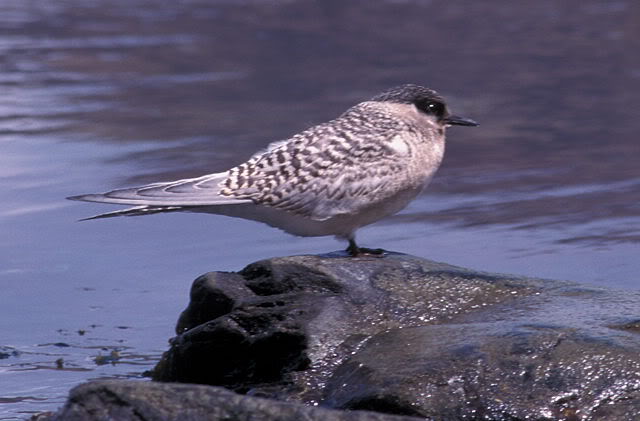
Juvenile
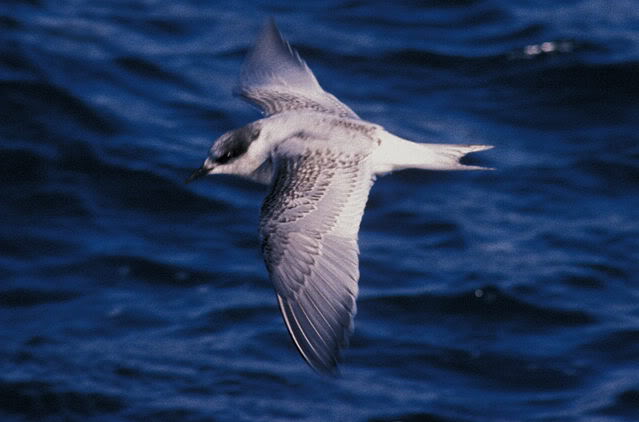
Juvenile
Links:
Sabap2
ARKive: http://www.arkive.org/antarctic-tern/sterna-vittata/
Avian Demography Unit
More photos by Dewi: https://africawild-forum.com/viewtopic. ... t=30#p3506

Breeding adult

Breeding adult

Breeding adult

Juvenile

Juvenile
Links:
Sabap2
ARKive: http://www.arkive.org/antarctic-tern/sterna-vittata/
Avian Demography Unit
More photos by Dewi: https://africawild-forum.com/viewtopic. ... t=30#p3506
Dewi
What is the good of having a nice house without a decent planet to put it on? (H D Thoreau)
What is the good of having a nice house without a decent planet to put it on? (H D Thoreau)
Whiskered Tern
338. Whiskered Tern Chlidonias hybrida (Witbaardsterretjie)
Order: Charadriiformes. Family: Laridae
Description
24-28 cm. The bill and legs of the Whiskered Tern are red, a striking feature that allows this species to be distinguished from other terns.
Silver grey upperparts with dark grey underparts in breeding plumage. Black cap with thick red bill. White cheeks and sides of neck.
It is in breeding plumage in summer, November–April, but as early as September in some years.
Non-breeding has white underparts and grey uppertail. Bill darkens. Black cap shrinks to leave a finely barred rear crown, with solid black patch behind the eye.
Juvenile: Pale brown scaly upperparts. Whitish underbelly with a gingery back speckled with dark black and brown.
Similar species: In breeding plumage this species resembles White-cheeked Tern, but is smaller and has a white vent and a less deeply forked tail. When in non-breeding plumage, it can easily be confused with the White-winged Tern, which occurs in the same habitat.
Distribution
On a global scale, the Whiskered Tern has a fragmented breeding distribution spanning the Old World: southern Europe, southern Asia, Australia, and eastern and southern Africa, including Madagascar. Birds from the nominate race, which breeds in the Palearctic, migrate to Africa, but remain north of the equator. Occurs in the non-arid areas of the sub-region, from Western Cape, along Southern coast, Central & Eastern South Africa, southern Mozambique, western and southern Zimbabwe, northern and eastern Botswana and northern Namibia (including the Caprivi Strip)
Habitat
Inland freshwater lakes, marshes and dams. It generally prefers natural wetlands, especially vleis, marshes and river flood plains with emergent vegetation, mainly breeding on temporary marshes and farm dams.
Movements and migrations
Breeding summer migrant to north-central Namibia, Zimbabwe, the South African highveld, the Western Cape and the Eastern Cape. It is largely resident in Botswana, north-western Zimbabwe and the tropical lowlands of Mozambique and KwaZulu-Natal.
Diet
Small fish, amphibians, insects and crustaceans. It mainly eats small fish, amphibians including Arum lily frogs (Hyperolius horstockii) plucked from Arum lilies (Zantedeschia aethiopica), insects and other invertebrates. It does most of its foraging in loose flocks, flying up wind, 2-4 metres above water.
Breeding
Monogamous and usually colonial, breeding in colonies of 5-30, rarely 60-80 pairs spread 2-20 metres apart. It is an opportunistic breeder, with laying dates often synchronised within the colony, as they all lay straight after heavy rain. The nest is built by both sexes, consisting of an untidy floating structure of plant stems, leaves and sometimes grass, which an be either flat or higher and more bulky depending on environmental conditions. Egg-laying season is from October-April, peaking from January-March in most of southern Africa excluding the Western Cape, where egg-laying is mainly from October-February, peaking from October-November. It lays 1-3 eggs, which are incubated by both sexes for about 20 days. The chicks can swim soon after hatching, taking to the water if predators before returning once the danger passes. The adults are aggressive in defence of their young, often attacking and dive bombing intruders such as humans. They fledge at about 20-27 days old, soon after which they start to practice foraging, although still regularly returning to the nest to be fed.
Call
Harsh chattering notes. Listen to Bird Call.
Status
Common resident and migrant in suitable habitat. Classified as Least Concern (LC) on the IUCN Red List.
Order: Charadriiformes. Family: Laridae
Description
24-28 cm. The bill and legs of the Whiskered Tern are red, a striking feature that allows this species to be distinguished from other terns.
Silver grey upperparts with dark grey underparts in breeding plumage. Black cap with thick red bill. White cheeks and sides of neck.
It is in breeding plumage in summer, November–April, but as early as September in some years.
Non-breeding has white underparts and grey uppertail. Bill darkens. Black cap shrinks to leave a finely barred rear crown, with solid black patch behind the eye.
Juvenile: Pale brown scaly upperparts. Whitish underbelly with a gingery back speckled with dark black and brown.
Similar species: In breeding plumage this species resembles White-cheeked Tern, but is smaller and has a white vent and a less deeply forked tail. When in non-breeding plumage, it can easily be confused with the White-winged Tern, which occurs in the same habitat.
Distribution
On a global scale, the Whiskered Tern has a fragmented breeding distribution spanning the Old World: southern Europe, southern Asia, Australia, and eastern and southern Africa, including Madagascar. Birds from the nominate race, which breeds in the Palearctic, migrate to Africa, but remain north of the equator. Occurs in the non-arid areas of the sub-region, from Western Cape, along Southern coast, Central & Eastern South Africa, southern Mozambique, western and southern Zimbabwe, northern and eastern Botswana and northern Namibia (including the Caprivi Strip)
Habitat
Inland freshwater lakes, marshes and dams. It generally prefers natural wetlands, especially vleis, marshes and river flood plains with emergent vegetation, mainly breeding on temporary marshes and farm dams.
Movements and migrations
Breeding summer migrant to north-central Namibia, Zimbabwe, the South African highveld, the Western Cape and the Eastern Cape. It is largely resident in Botswana, north-western Zimbabwe and the tropical lowlands of Mozambique and KwaZulu-Natal.
Diet
Small fish, amphibians, insects and crustaceans. It mainly eats small fish, amphibians including Arum lily frogs (Hyperolius horstockii) plucked from Arum lilies (Zantedeschia aethiopica), insects and other invertebrates. It does most of its foraging in loose flocks, flying up wind, 2-4 metres above water.
Breeding
Monogamous and usually colonial, breeding in colonies of 5-30, rarely 60-80 pairs spread 2-20 metres apart. It is an opportunistic breeder, with laying dates often synchronised within the colony, as they all lay straight after heavy rain. The nest is built by both sexes, consisting of an untidy floating structure of plant stems, leaves and sometimes grass, which an be either flat or higher and more bulky depending on environmental conditions. Egg-laying season is from October-April, peaking from January-March in most of southern Africa excluding the Western Cape, where egg-laying is mainly from October-February, peaking from October-November. It lays 1-3 eggs, which are incubated by both sexes for about 20 days. The chicks can swim soon after hatching, taking to the water if predators before returning once the danger passes. The adults are aggressive in defence of their young, often attacking and dive bombing intruders such as humans. They fledge at about 20-27 days old, soon after which they start to practice foraging, although still regularly returning to the nest to be fed.
Call
Harsh chattering notes. Listen to Bird Call.
Status
Common resident and migrant in suitable habitat. Classified as Least Concern (LC) on the IUCN Red List.
Dewi
What is the good of having a nice house without a decent planet to put it on? (H D Thoreau)
What is the good of having a nice house without a decent planet to put it on? (H D Thoreau)
Whiskered Tern Photos
338. Whiskered Tern Chlidonias hybrida
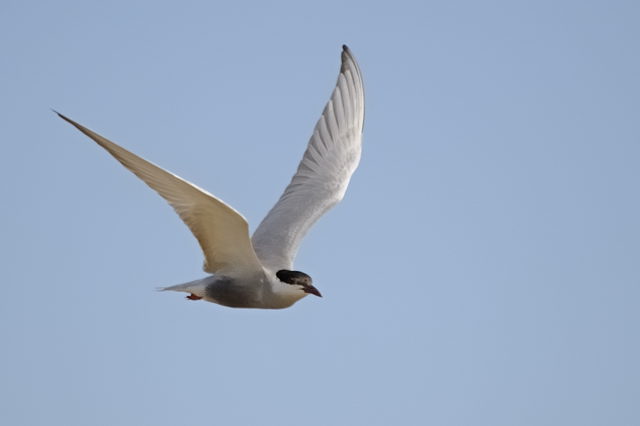
Breeding plumage
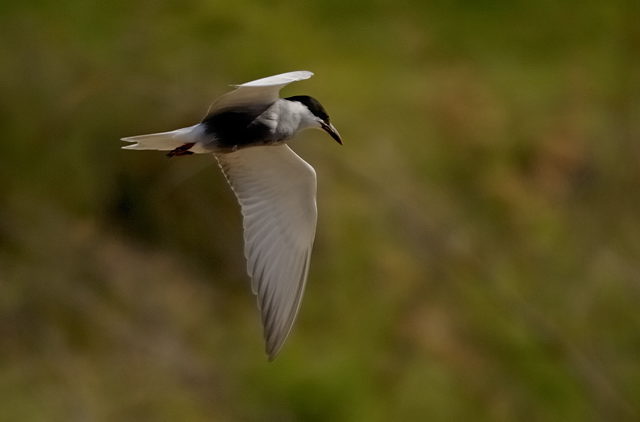
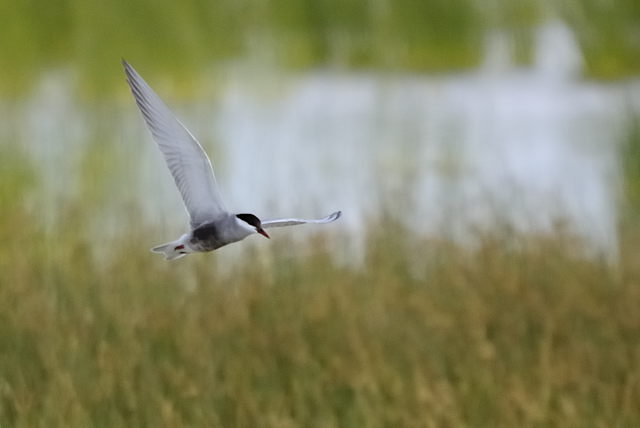
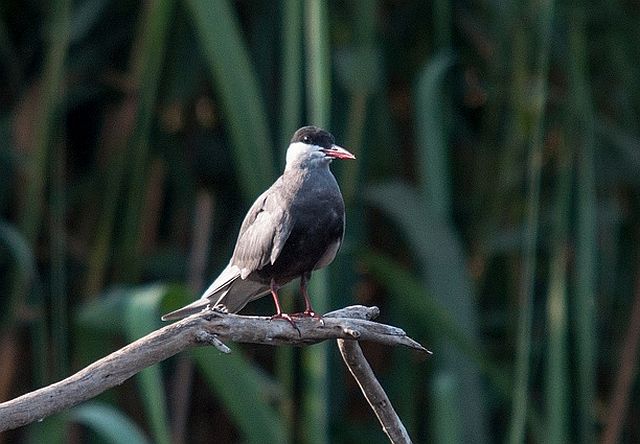 © steamtrainfan
© steamtrainfan
Rietvlei Nature Reserve
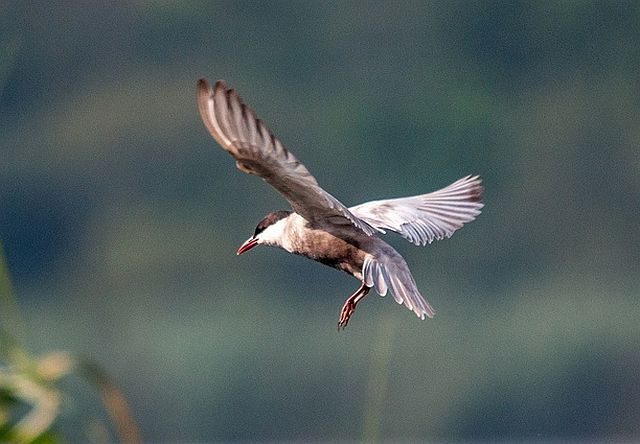 © steamtrainfan
© steamtrainfan
Rietvlei Nature Reserve
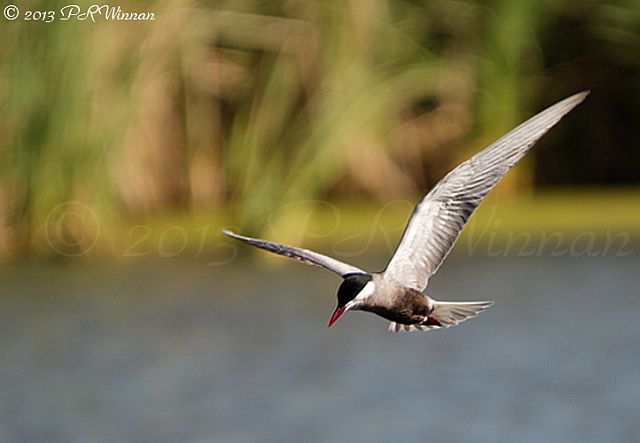 © PRWIN
© PRWIN
Marievale Bird Sanctuary
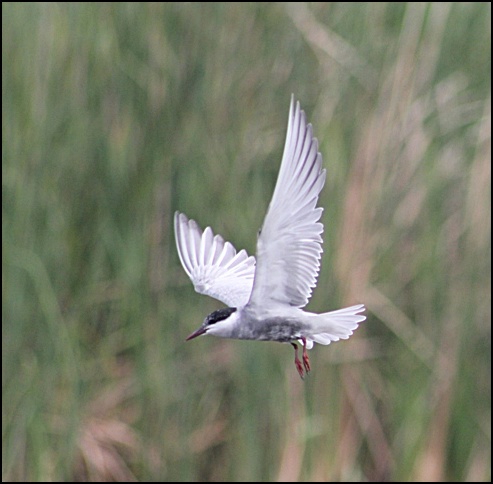 © Amoli
© Amoli
 © Amoli
© Amoli
Marievale Bird Sanctuary
Links:
http://sabap2.adu.org.za/spp_summary.ph ... §ion=3
Newman's birds of Southern Africa

Breeding plumage


 © steamtrainfan
© steamtrainfanRietvlei Nature Reserve
 © steamtrainfan
© steamtrainfanRietvlei Nature Reserve
 © PRWIN
© PRWINMarievale Bird Sanctuary
 © Amoli
© Amoli © Amoli
© AmoliMarievale Bird Sanctuary
Links:
http://sabap2.adu.org.za/spp_summary.ph ... §ion=3
Newman's birds of Southern Africa
Dewi
What is the good of having a nice house without a decent planet to put it on? (H D Thoreau)
What is the good of having a nice house without a decent planet to put it on? (H D Thoreau)
- Amoli
- Posts: 6032
- Joined: Fri Jun 01, 2012 4:30 am
- Country: South Africa
- Location: Kempton Park
- Contact:
White-winged Tern
339. White-winged Tern Chlidonias leucopterus (Witvlerksterretjie)
Order: Charadriiformes. Family: Laridae
Description
Adult birds in breeding plumage have short red legs and a short black bill (small and stubby, meausuring 22–25 mm from the feathers, decidedly shorter than the head), a black neck (often with a pale gray back) and belly, very dark grey back, with a white rump and light grey (almost white) tail, which often looks 'square' in juveniles. The face is tinged yellowish. The wings, as the name implies, are mainly white. The inner wing is grayish with brown-tipped coverts.
In non-breeding plumage, most of the black is replaced by white or pale grey, though a few blackish feathers may be retained, admixed with white underparts. A good deal of black shows in the underwing-coverts. The head is black, with a white forehead. The crown is blackish-brown, flecked with white, and the hindcrown is blackish with a certain amount of white flecking. These white markings are pronounced in the winter adult. There is a dark triangular patch forward of the eye. The collar is fairly broad and white.
In juveniles and moulting adults, the rump is pale gray, becoming grey in both phases late in the year. The clear white collar and rump isolate the mantle as a dark brown 'saddle'. The mantle feathers have narrow paler brown tips, as have the tertials and scapulars.
Distribution
Breeds in the area from China to central Europe, heading south in the non-breeding season to south-east Asia, northern Australia and most of sub-Saharan Africa. Within southern Africa it is common in southern Mozambique, Zimbabwe, northern and south-eastern Botswana, central and northern Namibia (including the Caprivi Strip) and central and south-western South Africa.
Habitat
It generally prefers inland wetlands, either natural or artificial, such as sewage works and salt pans; it is generally more scarce at coastal estuaries and wetlands.
Movements and migrations
In winter, they migrate to Africa, southern Asia and Australia. Breeding summer migrant to north-central Namibia, Zimbabwe, the South African highveld, the Western Cape and the Eastern Cape. It is largely resident in Botswana, north-western Zimbabwe and the tropical lowlands of Mozambique and KwaZulu-Natal.
Most birds arrive in southern Africa in the period from August-November, probably originating from breeding grounds in central Asia. In February it begins to gather in flocks at the South African highveld, before leaving the region by April.
Diet
Like the other "marsh" terns (Chlidonias), and unlike the "white" (Sterna) terns, these birds do not dive for fish, but fly slowly over the water to surface-pick items on the surface and catch insects in flight. It mainly eats invertebrates, amphibians and small fish, doing most of its foraging in flocks, flying upwind to catch flying insects before letting the wind carry it back so that it can repeat the process. It also regularly plunge dives for fish and is attracted to fishing boats, eating the fish they discard. Other techniques employed include following catfish (Clarias) to catch the animals disturb and seizing prey from the ground or water surface.
Breeding
The White-winged Tern inhabits inland freshwater marshes and lakes during the breeding season. Monogamous colonial nester, breeding in colonies of 5-30, rarely 60-80 pairs spread 2-20 metres apart. It is an opportunistic breeder, with laying dates often synchronised within the colony, as they all lay straight after heavy rain. The nest is built by both sexes, consisting of an untidy floating structure of plant stems, leaves and sometimes grass, which an be either flat or higher and more bulky depending on environmental conditions. Egg-laying season is from October-April, peaking from January-March in most of southern Africa excluding the Western Cape, where egg-laying is mainly from October-February, peaking from October-November. Two to three smooth, slightly glossy eggs are laid in each clutch, eggs are incubated by both sexes for about 20 days. The chicks can swim soon after hatching, taking to the water if predators before returning once the danger passes. The adults are aggressive in defence of their young, often attacking and dive bombing intruders such as humans. They fledge at about 20-27 days old, soon after which they start to practice foraging, although still regularly returning to the nest to be fed.
Status
Common summer visitor.
Order: Charadriiformes. Family: Laridae
Description
Adult birds in breeding plumage have short red legs and a short black bill (small and stubby, meausuring 22–25 mm from the feathers, decidedly shorter than the head), a black neck (often with a pale gray back) and belly, very dark grey back, with a white rump and light grey (almost white) tail, which often looks 'square' in juveniles. The face is tinged yellowish. The wings, as the name implies, are mainly white. The inner wing is grayish with brown-tipped coverts.
In non-breeding plumage, most of the black is replaced by white or pale grey, though a few blackish feathers may be retained, admixed with white underparts. A good deal of black shows in the underwing-coverts. The head is black, with a white forehead. The crown is blackish-brown, flecked with white, and the hindcrown is blackish with a certain amount of white flecking. These white markings are pronounced in the winter adult. There is a dark triangular patch forward of the eye. The collar is fairly broad and white.
In juveniles and moulting adults, the rump is pale gray, becoming grey in both phases late in the year. The clear white collar and rump isolate the mantle as a dark brown 'saddle'. The mantle feathers have narrow paler brown tips, as have the tertials and scapulars.
Distribution
Breeds in the area from China to central Europe, heading south in the non-breeding season to south-east Asia, northern Australia and most of sub-Saharan Africa. Within southern Africa it is common in southern Mozambique, Zimbabwe, northern and south-eastern Botswana, central and northern Namibia (including the Caprivi Strip) and central and south-western South Africa.
Habitat
It generally prefers inland wetlands, either natural or artificial, such as sewage works and salt pans; it is generally more scarce at coastal estuaries and wetlands.
Movements and migrations
In winter, they migrate to Africa, southern Asia and Australia. Breeding summer migrant to north-central Namibia, Zimbabwe, the South African highveld, the Western Cape and the Eastern Cape. It is largely resident in Botswana, north-western Zimbabwe and the tropical lowlands of Mozambique and KwaZulu-Natal.
Most birds arrive in southern Africa in the period from August-November, probably originating from breeding grounds in central Asia. In February it begins to gather in flocks at the South African highveld, before leaving the region by April.
Diet
Like the other "marsh" terns (Chlidonias), and unlike the "white" (Sterna) terns, these birds do not dive for fish, but fly slowly over the water to surface-pick items on the surface and catch insects in flight. It mainly eats invertebrates, amphibians and small fish, doing most of its foraging in flocks, flying upwind to catch flying insects before letting the wind carry it back so that it can repeat the process. It also regularly plunge dives for fish and is attracted to fishing boats, eating the fish they discard. Other techniques employed include following catfish (Clarias) to catch the animals disturb and seizing prey from the ground or water surface.
Breeding
The White-winged Tern inhabits inland freshwater marshes and lakes during the breeding season. Monogamous colonial nester, breeding in colonies of 5-30, rarely 60-80 pairs spread 2-20 metres apart. It is an opportunistic breeder, with laying dates often synchronised within the colony, as they all lay straight after heavy rain. The nest is built by both sexes, consisting of an untidy floating structure of plant stems, leaves and sometimes grass, which an be either flat or higher and more bulky depending on environmental conditions. Egg-laying season is from October-April, peaking from January-March in most of southern Africa excluding the Western Cape, where egg-laying is mainly from October-February, peaking from October-November. Two to three smooth, slightly glossy eggs are laid in each clutch, eggs are incubated by both sexes for about 20 days. The chicks can swim soon after hatching, taking to the water if predators before returning once the danger passes. The adults are aggressive in defence of their young, often attacking and dive bombing intruders such as humans. They fledge at about 20-27 days old, soon after which they start to practice foraging, although still regularly returning to the nest to be fed.
Status
Common summer visitor.
Pretoriuskop
Satara
Shingwedzi
20-30 Dec 2014
Satara
Shingwedzi
20-30 Dec 2014
- Amoli
- Posts: 6032
- Joined: Fri Jun 01, 2012 4:30 am
- Country: South Africa
- Location: Kempton Park
- Contact:
White-winged Tern Photos
339. White-winged Tern Chlidonias leucopterus
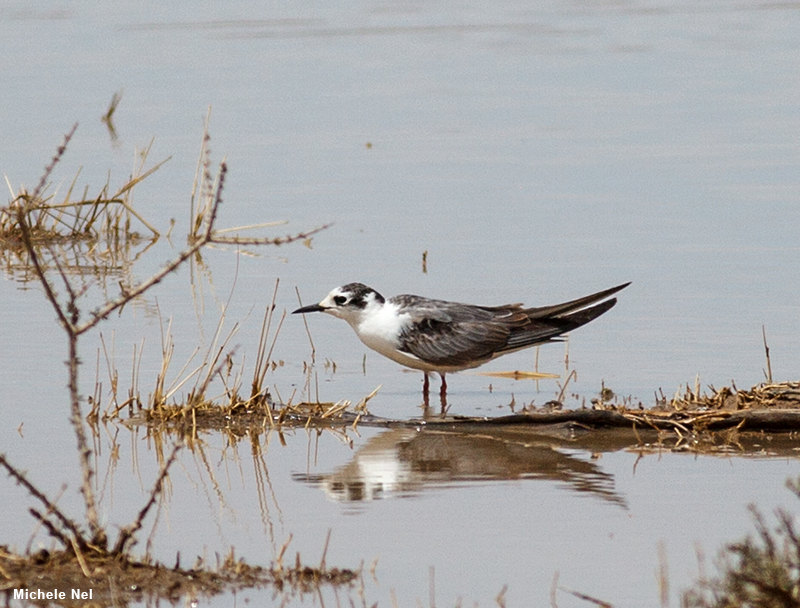 Michele Nel
Michele Nel
Kgalagadi Transfrontier Park, Samevloeiing - Dec 27 2016
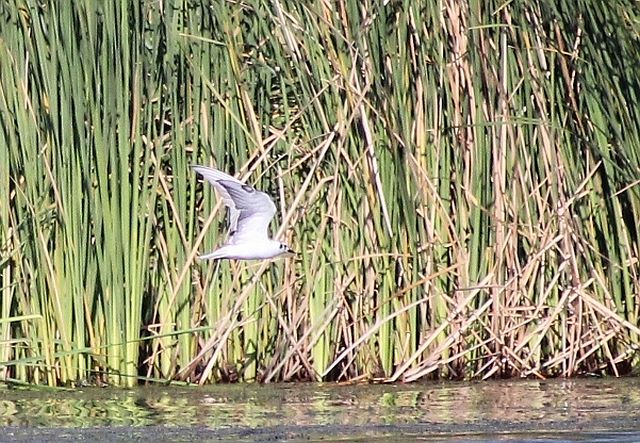
Non-breeding adult
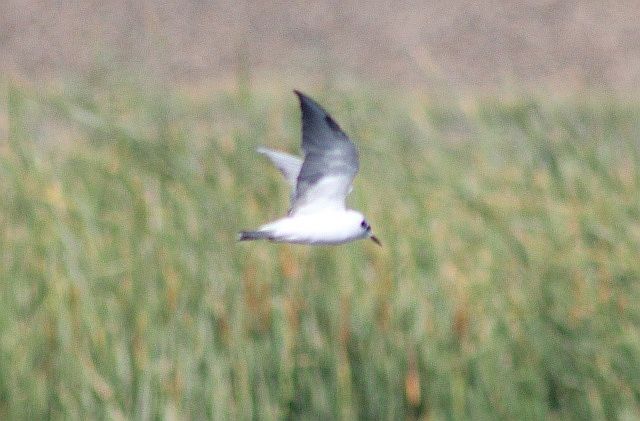
Rietvlei Nature Reserve, Gauteng
Links:
Wikipedia
http://sabap2.adu.org.za/spp_summary.ph ... §ion=3
http://sabap2.adu.org.za/docs/sabap1/339.pdf
 Michele Nel
Michele NelKgalagadi Transfrontier Park, Samevloeiing - Dec 27 2016

Non-breeding adult

Rietvlei Nature Reserve, Gauteng
Links:
Wikipedia
http://sabap2.adu.org.za/spp_summary.ph ... §ion=3
http://sabap2.adu.org.za/docs/sabap1/339.pdf
Pretoriuskop
Satara
Shingwedzi
20-30 Dec 2014
Satara
Shingwedzi
20-30 Dec 2014
Family Stercorariidae (Skuas)
The skuas are a group of seabirds with about seven species forming the family Stercorariidae and the genus Stercorarius. The three smaller skuas are called jaegers in the Americas.
Skuas nest on the ground in temperate and Arctic regions, and are long-distance migrants.
Outside the breeding season, skuas take fish, offal, and carrion. Many are partial kleptoparasites, comprising up to 95% of the feeding methods of wintering birds, by chasing gulls, terns and other seabirds to steal their catches, regardless of the size of the species attacked (up to 3 times heavier than the attacking skua). The larger species also regularly kill and eat adult birds, such as puffins and gulls, and have been recorded as killing birds as large as a Grey Heron. On the breeding grounds, the three, more slender Northern breeding species commonly eat lemmings. Those species that breed in the Southern Oceans, largely feed on fish that can be caught near their colonies. The eggs and young of other birds are an important food source for most skua species during the nesting season. In the Southern oceans and Antarctica region, some skua species (especially the South Polar Skua) will readily scavenge the carcasses at breeding colonies of penguins and pinnipeds, sometimes taking live penguin chicks. In these areas, skuas seem to defer to the considerably larger giant petrels.
They are medium to large birds, typically with grey or brown plumage, often with white markings on the wings. The skuas range in size from the Long-tailed Skua, Stercorarius longicauda, at 310 grams, to the Brown Skua, Stercorarius antarcticus, at 1.63 kg. On average, a skua is about 56 cm long, and 121 cm across the wings. They have longish bills with a hooked tip, and webbed feet with sharp claws. They look like large dark gulls, but have a fleshy cere above the upper mandible. The skuas are strong, acrobatic fliers. They are generally aggressive in disposition. Potential predators who go near their nest will be quickly dived at by the parent bird, which usually targets the head of the intruder - a practice known as 'dive bombing'.
Links:
Malling Olsen Klaus: Skuas and Jaegers
Skuas nest on the ground in temperate and Arctic regions, and are long-distance migrants.
Outside the breeding season, skuas take fish, offal, and carrion. Many are partial kleptoparasites, comprising up to 95% of the feeding methods of wintering birds, by chasing gulls, terns and other seabirds to steal their catches, regardless of the size of the species attacked (up to 3 times heavier than the attacking skua). The larger species also regularly kill and eat adult birds, such as puffins and gulls, and have been recorded as killing birds as large as a Grey Heron. On the breeding grounds, the three, more slender Northern breeding species commonly eat lemmings. Those species that breed in the Southern Oceans, largely feed on fish that can be caught near their colonies. The eggs and young of other birds are an important food source for most skua species during the nesting season. In the Southern oceans and Antarctica region, some skua species (especially the South Polar Skua) will readily scavenge the carcasses at breeding colonies of penguins and pinnipeds, sometimes taking live penguin chicks. In these areas, skuas seem to defer to the considerably larger giant petrels.
They are medium to large birds, typically with grey or brown plumage, often with white markings on the wings. The skuas range in size from the Long-tailed Skua, Stercorarius longicauda, at 310 grams, to the Brown Skua, Stercorarius antarcticus, at 1.63 kg. On average, a skua is about 56 cm long, and 121 cm across the wings. They have longish bills with a hooked tip, and webbed feet with sharp claws. They look like large dark gulls, but have a fleshy cere above the upper mandible. The skuas are strong, acrobatic fliers. They are generally aggressive in disposition. Potential predators who go near their nest will be quickly dived at by the parent bird, which usually targets the head of the intruder - a practice known as 'dive bombing'.
Links:
Malling Olsen Klaus: Skuas and Jaegers
Family Stercorariidae (Skuas) Index
Species indigenous to southern Africa:
Family Stercorariidae (Skuas)
Stercorarius maccormicki South Polar Skua 311
Stercorarius antarcticus Brown Skua, Subantarctic Skua 310
Stercorarius pomarinus Pomarine Jaeger 309
Stercorarius parasiticus Parasitic Jaeger 307
Stercorarius longicaudus Long-tailed Jaeger 308
Family Stercorariidae (Skuas)
Stercorarius maccormicki South Polar Skua 311
Stercorarius antarcticus Brown Skua, Subantarctic Skua 310
Stercorarius pomarinus Pomarine Jaeger 309
Stercorarius parasiticus Parasitic Jaeger 307
Stercorarius longicaudus Long-tailed Jaeger 308


